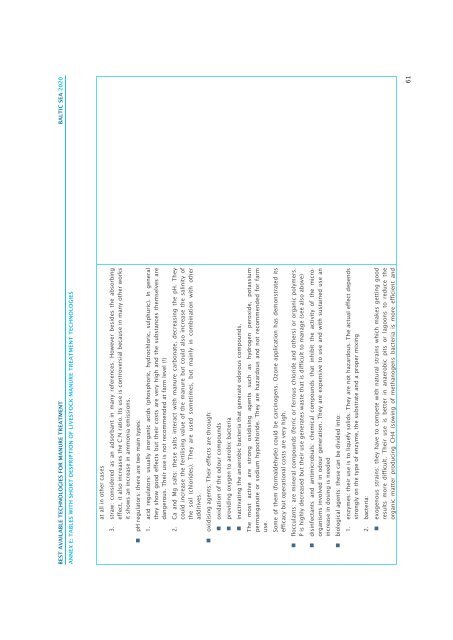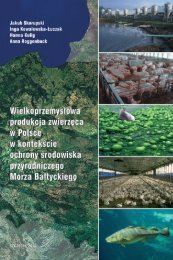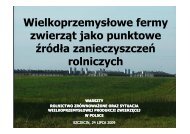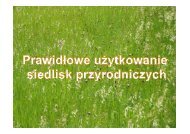best available technologies for manure treatment - Baltic Green Belt
best available technologies for manure treatment - Baltic Green Belt
best available technologies for manure treatment - Baltic Green Belt
You also want an ePaper? Increase the reach of your titles
YUMPU automatically turns print PDFs into web optimized ePapers that Google loves.
Best Available Technologies <strong>for</strong> <strong>manure</strong> <strong>treatment</strong> baltic sea 2020<br />
Best Available Technologies <strong>for</strong> <strong>manure</strong> <strong>treatment</strong> baltic sea 2020<br />
ANNEX E: TABLES WITH SHORT DESPRIPTION OF LIVESTOCK MANURE TREATMENT TECHNOLOGIES<br />
Best Available Techniques <strong>for</strong> <strong>manure</strong> <strong>treatment</strong> - <strong>for</strong> intensive rearing of pigs in <strong>Baltic</strong> Sea Region EU Member States Technical Report "Best Practice Manure Handling, Phase 2"<br />
at all in other cases<br />
3. straw: considered as an adsorbant in many references. However besides the absorbing<br />
effect, it also increases the C:N ratio. Its use is controversial because in many other works<br />
it shows an increase in ammonia emissions.<br />
pH regulators: there are two main types:<br />
1. acid regulators: usually inorganic acids (phosphoric, hydrochloric, sulphuric). In general<br />
they show good effects but their costs are very high and the substances themselves are<br />
dangerous. Their use is not recommended at farm level (!)<br />
2. Ca and Mg salts: these salts interact with <strong>manure</strong> carbonate, decreasing the pH. They<br />
could increase the fertilising value of the <strong>manure</strong> but could also increase the salinity of<br />
the soil (chlorides). They are used sometimes, but mainly in combination with other<br />
additives.<br />
oxidising agents: Their effects are through:<br />
oxidation of the odour compounds<br />
providing oxygen to aerobic bacteria<br />
inactivating the anaerobic bacteria that generate odorous compounds.<br />
The most active are strong oxidising agents such as hydrogen peroxide, potassium<br />
permanganate or sodium hypochloride. They are hazardous and not recommended <strong>for</strong> farm<br />
use.<br />
Some of them (<strong>for</strong>maldehyde) could be carcinogens. Ozone application has demonstrated its<br />
efficacy but operational costs are very high.<br />
flocculants: are mineral compounds (ferric or ferrous chloride and others) or organic polymers.<br />
P is highly decreased but their use generates waste that is difficult to manage (see also above)<br />
disinfectants and antimicrobials: chemical compounds that inhibit the activity of the microorganisms<br />
involved in odour generation. They are expensive to use and with sustained use an<br />
increase in dosing is needed<br />
biological agents: these can be divided into:<br />
1. enzymes: their use is to liquefy solids. They are not hazardous. The actual effect depends<br />
strongly on the type of enzyme, the substrate and a proper mixing<br />
2. bacteria:<br />
exogenous strains: they have to compete with natural strains which makes getting good<br />
results more difficult. Their use is better in anaerobic pits or lagoons to reduce the<br />
organic matter producing CH4 (sowing of methanogens bacteria is more efficient and<br />
61<br />
Side 62<br />
61








